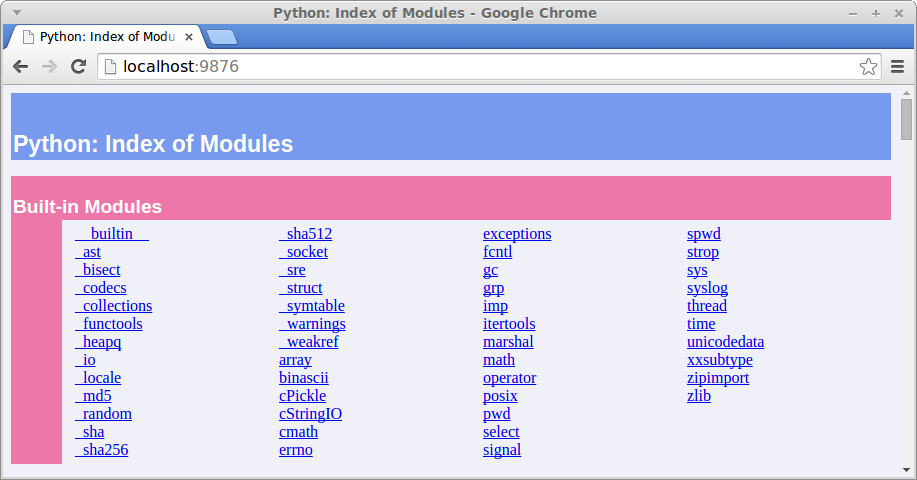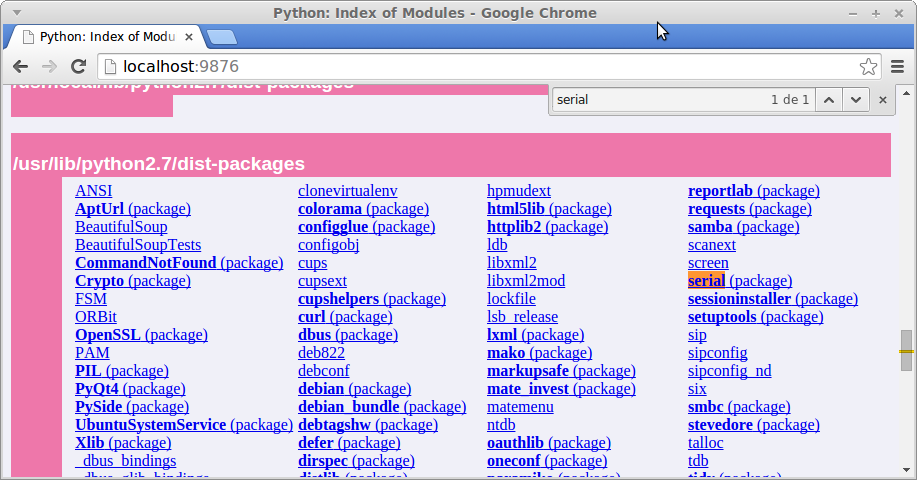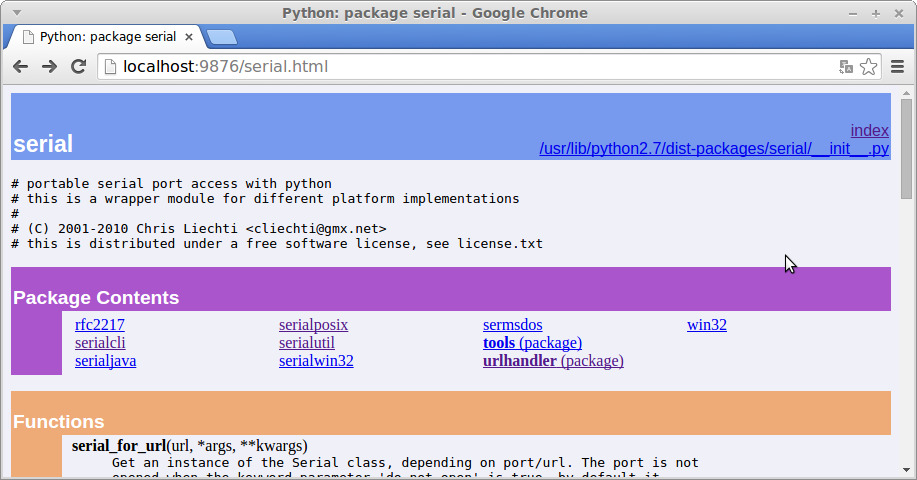Pydoc é uma grande ferramenta do leque do Python, que pode ser utilizada para gerar documentação dos módulos baseado em docstrings[1] e também ter acesso a essa documentação, naquele famoso estilo man-pages.
Imagina você querendo saber informações ou ajuda sobre um modulo mais esta sem internet, então nosso amigo Google não poderá ajudar, vamos de pydoc[2] então.
O mais trivial e que sempre uso é pydoc e o nome do modulo, irei tomar como exemplo o serial (modulo de comunicação serial do Python [pyserial][3]).
$ pydoc serial
Help on package serial:
NAME
serial
FILE
/usr/lib/python2.7/dist-packages/serial/__init__.py
DESCRIPTION
# portable serial port access with python
# this is a wrapper module for different platform implementations
#
# (C) 2001-2010 Chris Liechti <[email protected]>
# this is distributed under a free software license, see license.txt
PACKAGE CONTENTS
rfc2217
serialcli
serialjava
serialposix
serialutil
serialwin32
sermsdos
tools (package)
urlhandler (package)
win32
FUNCTIONS
serial_for_url(url, *args, **kwargs)
Get an instance of the Serial class, depending on port/url. The port is not
opened when the keyword parameter 'do_not_open' is true, by default it
is. All other parameters are directly passed to the __init__ method when
the port is instantiated.
The list of package names that is searched for protocol handlers is kept in
``protocol_handler_packages``.
e.g. we want to support a URL ``foobar://``. A module
``my_handlers.protocol_foobar`` is provided by the user. Then
Irei postar só uma parte do conteúdo, o mais legal e que mais gosto de usar é o acesso direto no que preciso. Como assim? Por exemplo, eu quero conhecer a classe Serial do modulo, então faço assim.
$ pydoc serial.Serial Help on class Serial in serial: serial.Serial = class Serial(PosixSerial, io.RawIOBase) | # classic version with our own file-like emulation | | Method resolution order: | Serial | PosixSerial | serial.serialutil.SerialBase | io.RawIOBase | _io._RawIOBase | io.IOBase | _io._IOBase | __builtin__.object | | Data and other attributes defined here: | | __abstractmethods__ = frozenset([]) | | ---------------------------------------------------------------------- | Methods inherited from PosixSerial: | | close(self) | Close port | | drainOutput(self) | internal - not portable! | | fileno(self) | For easier use of the serial port instance with select. | WARNING: this function is not portable to different platforms! | | flowControl(self, enable) | manually control flow - when hardware or software flow control is | enabled | | flush(self) | Flush of file like objects. In this case, wait until all data | is written. : .....
Muito legal, agora eu sei que quando crio um objeto com serial.Serial(), tenho todos estes métodos para usar, e se eu precisar de ajuda ou queira conhecer algum destes métodos.
$ pydoc serial.Serial.flushInput
Help on method flushInput in serial.Serial:
serial.Serial.flushInput = flushInput(self) unbound serial.serialposix.Serial method
Clear input buffer, discarding all that is in the buffer.
(END)
$ pydoc serial.Serial.read
Help on method read in serial.Serial:
serial.Serial.read = read(self, size=1) unbound serial.serialposix.Serial method
Read size bytes from the serial port. If a timeout is set it may
return less characters as requested. With no timeout it will block
until the requested number of bytes is read.
No exemplo acima, estou acessando o conteúdo de flushInput e read da classe Serial.
E quando você quer pesquisar algo e não sabe o nome do modulo, vamos de pydoc[2] também.
$ pydoc -k serial
pickle - Create portable serialized representations of Python objects.
html5lib.serializer
html5lib.serializer.htmlserializer
No handlers could be found for logger "oneconf.distributor"
piston_mini_client.serializers - Classes that define ways for your API methods to serialize arguments
serial
serial.rfc2217
serial.serialcli
serial.serialjava
serial.serialposix
serial.serialutil
serial.serialwin32
serial.sermsdos
serial.tools
serial.tools.list_ports - This module will provide a function called comports that returns an
serial.tools.list_ports_posix
serial.tools.list_ports_windows
serial.tools.miniterm
serial.urlhandler
serial.urlhandler.protocol_hwgrep
serial.urlhandler.protocol_loop
serial.urlhandler.protocol_rfc2217
serial.urlhandler.protocol_socket
serial.win32
twisted.internet._posixserialport - Serial Port Protocol
twisted.internet._win32serialport - Serial port support for Windows.
twisted.internet.serialport - Serial Port Protocol
twisted.internet.test.test_serialport - Tests for L{twisted.internet.serialport}.
twisted.protocols.gps.rockwell - Rockwell Semiconductor Zodiac Serial Protocol
twisted.protocols.mice.mouseman - Logictech MouseMan serial protocol.
twisted.test.test_jelly - Test cases for L{jelly} object serialization.
twisted.web._flatten - Context-free flattener/serializer for rendering Python objects, possibly
Com o parâmetro -k estamos especificando uma palavra-chave para busca, e no caso usei serial.
Você acha que acabou? Imagina esse poder além dos terminais. E você tem, pois consegue subir um “webserver” para acessar tudo isso localmente pelo navegador.
$ pydoc -p 9876 pydoc server ready at http://localhost:9876/
Procurando o modulo serial na pagina.
Acessando o modulo e visualizando o conteúdo.
E para fechar com chave de ouro, e se pudéssemos pesquisar sobre o que quiséssemos e pudesse gerar uma pagina dessas para visualizar via web, vamos fazer.
$ pydoc -w serial wrote serial.html
E gerou uma pagina chamada serial.html no local que esta sendo executado o pydoc, com todo o conteúdo do modulo serial que pode ser visualizado via web e até impresso.
Isso porque eu não falei que dentro do Python você pode usar o help() ;)
Espero que tenham gostado, e até a próxima!
Referências
[1] – http://pt.wikibooks.org/wiki/Python/Conceitos_b%C3%A1sicos/Coment%C3%A1rios_e_docstrings
[2] – https://docs.python.org/2/library/pydoc.html
[3] – https://pypi.python.org/pypi/pyserial
![]() Python – Pydoc by Cleiton Bueno is licensed under a Creative Commons Attribution-NonCommercial-ShareAlike 4.0 International License.
Python – Pydoc by Cleiton Bueno is licensed under a Creative Commons Attribution-NonCommercial-ShareAlike 4.0 International License.





